Chicago Astronomers Joe and Bill came out to Indiana Dunes State Park Tuesday, October 5 for a deep sky and Comet Hartley observation. Before leaving that night, park rangers invited them to come back out for an all night session, away from public eyes if they chose. Saturday, October 9, Joe and Bill took the rangers up on the offer.
I was running late (of course), and had to stop at Kmart for an SD card for my camera, and then something to eat before going to the Dunes all night. While waiting in the Taco Bell drive-thru in Chesterton, I spotted the 2 day old Moon at 6:20 PM CDST, winning Chicago Astronomer Curt’s New Moon Challenge!
We were only about two miles from the state park, so I hurried to catch the Moon before setting. My friends Candi and Stephanie were also waiting to see some things before Hillary and I joined Joe and Bill. The only line of sight for the Moon was on the beach. I wasn’t thrilled about possibly getting sand in the mount, but it had to be done. We followed the Moon for a few minutes before it dropped among the trees in the distance.
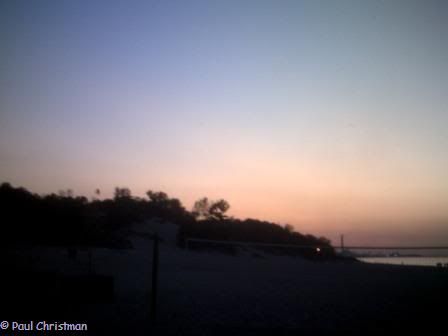
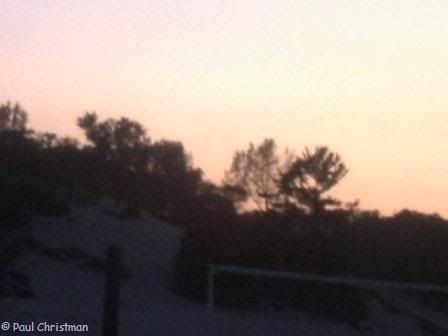
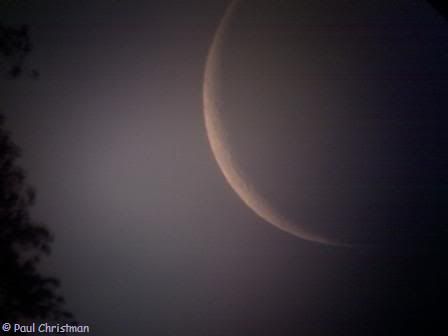
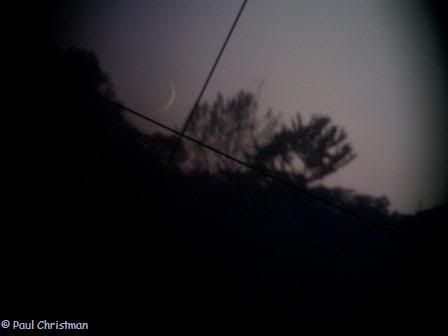
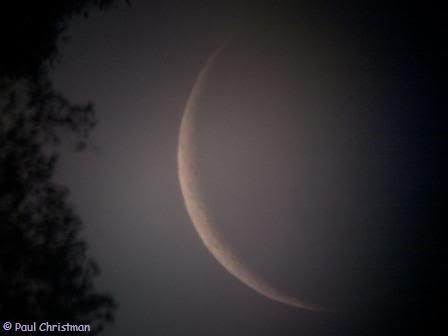
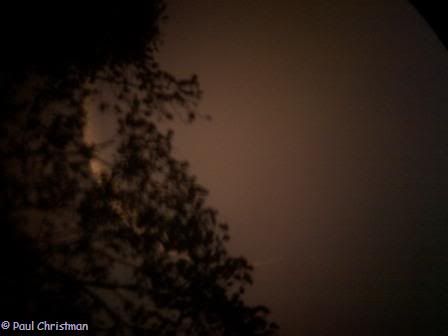
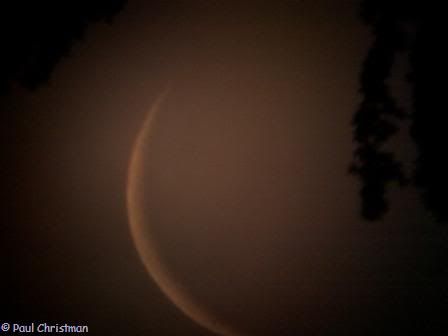
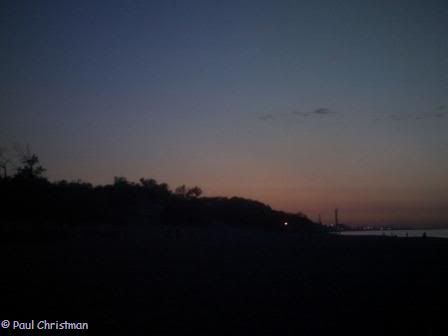
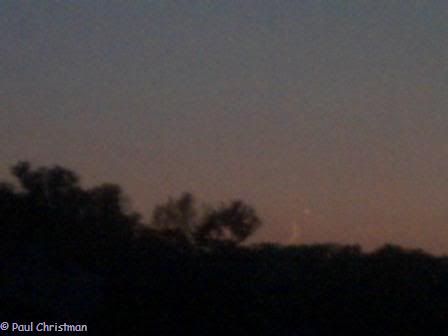
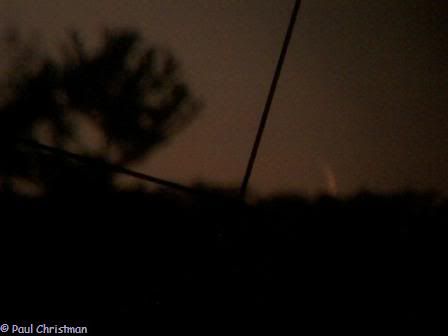
After losing the Moon, I took the telescope back to the parking lot to observe Jupiter while waiting for darkness to fall. We had a lineup of Galilean Moons like I’ve never seen before. One was behind Jupiter, and the other three were to the left (west) in an almost perfect equatorial triangle. Callisto was the bottom point, moving towards the planet, while the other two were travelling away from Jupiter.

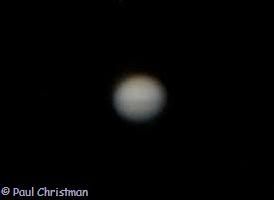
I took Stephanie and Candi through a quick tour of the showpieces of the evening, including the Owl/E.T. Cluster, the Double Cluster, the Ring Nebula, Andromeda Galaxy, with a description of each. I forgot Uranus, but pointed out the star Fomalhaut, which I’ve been making a point to do since the discovery of exoplanet Gliese 581g. Gliese 581g is the first possible Earth-like exoplanet residing in it’s star’s habitable zone. Since it’s announced discovery people have been asking about it specifically, and exoplanets generally. Fomalhaut is a unique star to point out because it is only one of three star systems with exoplanets directly imaged.
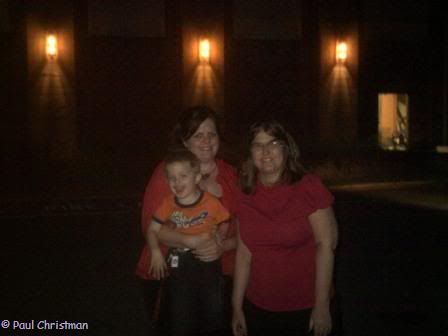
Stephanie, her son Brandon, and Candi.
Hillary had some personal issues on her mind, and I was anxious to find Joe and Bill, so I kept the observation short. I knew Joe wanted it to be a private observation, so I didn’t invite Candi and Stephanie to join us. In retrospect, I think it would have been okay for them to come over for a little while.
We drove over to the west parking lot, which I have walked past from the beach dozens of times and never knew it was there because a sand dune blocks it from view by the Lake. I killed the headlights and saw several red lights in the middle of the parking lot, and slowly drove over. Getting out of my car turned into a small adventure, since I have no way to turn off the dome light when the doors open. I climbed out the window, Dukes of Hazzard style, and draped a blanket over the driver’s side to block the light while we had the doors open.

Joe, observing with his C11, bathed in red light. Photo credit: Joe Guzman.

Hillary offering Joe a cookie. Photo credit: Joe Guzman.
By coincidence, Larry from Michigan City was observing when Bill and Joe arrived. I met Larry only a few days before, at the Porter County Commissioners meeting. Larry had a homemade Dobsonian, built from scrap wood. Mac, a young Chicago Astronomer was there with his dad and his Orion short tube 6” Dobsonian. Bill had brought his 5” Vixen Newtonian for astro-imaging, and of course Joe had the C11.
I slowly set up my 6” Dob, enjoying the early night, letting my eyes adapt to the darkness, and soaking up starlight. There was no hurry, we had all night for viewing. My first order of business was Comet Hartley, or course. I was expecting a difficult endeavor, but finally the comet actually looked like a COMET! I couldn’t believe it was so easy, so I called Bill over to verify. He agreed. It was soon obvious, as Hartley approached the star Miram, passing it around midnight.
As a group we observed dozens of targets through the night. One of my highlights was when Bill found M33, the Pinwheel Galaxy. I had long ago given up on it, but it was one of the first deep sky objects I’d ever tried to find. Globular cluster M15 was another first for me. I’m not sure how I’ve overlooked adding it to my observing list for so long. I also was on a stellar remnant kick. Usually the Ring Nebula is the only planetary nebula I observe, but I hit up M27 (again, I’m not sure why I overlook an easy target). When Gemini rose, I tried for the Eskimo Nebula, another sight that had always eluded me. I gave up on it quite a few times again, but kept coming back to it. Finally, absolutely sure of my star hop, I took a closer look. Bill was also looking for it, and I compared the views. It wasn’t what I was expecting, but I had definitely been dead on with my star hops. It didn’t look impressive until we put the power of the C11 on it. I also added M1, the Crab Nebula, to the stellar corpses observed that night. One of my last targets of the night was a challenge, something I’d never tried to find. The Cat’s Eye Nebula was rather low, out over the Lake Michigan, but I managed to track it down.
Mac and his dad left when the park closed, but Mac was pushing us all to our limits. At Mac’s suggestion, Bill tried for the Veil Nebula. With a time exposure image, he was able to pick up nebulosity. I’m not equipped for astrophotography, but it was cool to see some of the nice images that Bill and Joe were getting.
The temperature stayed comfortable most of the night. The last two hours turned chilly, and we were ready to go just before daylight broke through. Only Bill, Joe, Hillary, and I stayed all night, but we had a nice group for a star party the first half of the night. Like all good astronomers, we pushed each other to find new treats in the sky, and enjoyed sharing our finds with the group. It will go down as one of my best personal sessions, and having great company around only made it better.
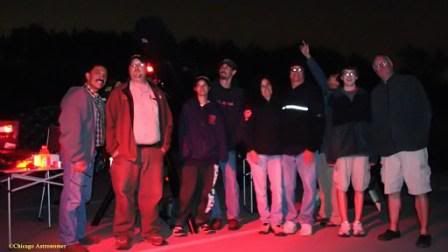
What a great group to observe with! Photo credit: Joe Guzman.
Read our accounts and see some of the images taken that night here:
http://astronomer.proboards.com/index.cgi?action=display&board=Observations&thread=2913&page=1
I was running late (of course), and had to stop at Kmart for an SD card for my camera, and then something to eat before going to the Dunes all night. While waiting in the Taco Bell drive-thru in Chesterton, I spotted the 2 day old Moon at 6:20 PM CDST, winning Chicago Astronomer Curt’s New Moon Challenge!
We were only about two miles from the state park, so I hurried to catch the Moon before setting. My friends Candi and Stephanie were also waiting to see some things before Hillary and I joined Joe and Bill. The only line of sight for the Moon was on the beach. I wasn’t thrilled about possibly getting sand in the mount, but it had to be done. We followed the Moon for a few minutes before it dropped among the trees in the distance.










After losing the Moon, I took the telescope back to the parking lot to observe Jupiter while waiting for darkness to fall. We had a lineup of Galilean Moons like I’ve never seen before. One was behind Jupiter, and the other three were to the left (west) in an almost perfect equatorial triangle. Callisto was the bottom point, moving towards the planet, while the other two were travelling away from Jupiter.


I took Stephanie and Candi through a quick tour of the showpieces of the evening, including the Owl/E.T. Cluster, the Double Cluster, the Ring Nebula, Andromeda Galaxy, with a description of each. I forgot Uranus, but pointed out the star Fomalhaut, which I’ve been making a point to do since the discovery of exoplanet Gliese 581g. Gliese 581g is the first possible Earth-like exoplanet residing in it’s star’s habitable zone. Since it’s announced discovery people have been asking about it specifically, and exoplanets generally. Fomalhaut is a unique star to point out because it is only one of three star systems with exoplanets directly imaged.

Stephanie, her son Brandon, and Candi.
Hillary had some personal issues on her mind, and I was anxious to find Joe and Bill, so I kept the observation short. I knew Joe wanted it to be a private observation, so I didn’t invite Candi and Stephanie to join us. In retrospect, I think it would have been okay for them to come over for a little while.
We drove over to the west parking lot, which I have walked past from the beach dozens of times and never knew it was there because a sand dune blocks it from view by the Lake. I killed the headlights and saw several red lights in the middle of the parking lot, and slowly drove over. Getting out of my car turned into a small adventure, since I have no way to turn off the dome light when the doors open. I climbed out the window, Dukes of Hazzard style, and draped a blanket over the driver’s side to block the light while we had the doors open.

Joe, observing with his C11, bathed in red light. Photo credit: Joe Guzman.

Hillary offering Joe a cookie. Photo credit: Joe Guzman.
By coincidence, Larry from Michigan City was observing when Bill and Joe arrived. I met Larry only a few days before, at the Porter County Commissioners meeting. Larry had a homemade Dobsonian, built from scrap wood. Mac, a young Chicago Astronomer was there with his dad and his Orion short tube 6” Dobsonian. Bill had brought his 5” Vixen Newtonian for astro-imaging, and of course Joe had the C11.
I slowly set up my 6” Dob, enjoying the early night, letting my eyes adapt to the darkness, and soaking up starlight. There was no hurry, we had all night for viewing. My first order of business was Comet Hartley, or course. I was expecting a difficult endeavor, but finally the comet actually looked like a COMET! I couldn’t believe it was so easy, so I called Bill over to verify. He agreed. It was soon obvious, as Hartley approached the star Miram, passing it around midnight.
As a group we observed dozens of targets through the night. One of my highlights was when Bill found M33, the Pinwheel Galaxy. I had long ago given up on it, but it was one of the first deep sky objects I’d ever tried to find. Globular cluster M15 was another first for me. I’m not sure how I’ve overlooked adding it to my observing list for so long. I also was on a stellar remnant kick. Usually the Ring Nebula is the only planetary nebula I observe, but I hit up M27 (again, I’m not sure why I overlook an easy target). When Gemini rose, I tried for the Eskimo Nebula, another sight that had always eluded me. I gave up on it quite a few times again, but kept coming back to it. Finally, absolutely sure of my star hop, I took a closer look. Bill was also looking for it, and I compared the views. It wasn’t what I was expecting, but I had definitely been dead on with my star hops. It didn’t look impressive until we put the power of the C11 on it. I also added M1, the Crab Nebula, to the stellar corpses observed that night. One of my last targets of the night was a challenge, something I’d never tried to find. The Cat’s Eye Nebula was rather low, out over the Lake Michigan, but I managed to track it down.
Mac and his dad left when the park closed, but Mac was pushing us all to our limits. At Mac’s suggestion, Bill tried for the Veil Nebula. With a time exposure image, he was able to pick up nebulosity. I’m not equipped for astrophotography, but it was cool to see some of the nice images that Bill and Joe were getting.
The temperature stayed comfortable most of the night. The last two hours turned chilly, and we were ready to go just before daylight broke through. Only Bill, Joe, Hillary, and I stayed all night, but we had a nice group for a star party the first half of the night. Like all good astronomers, we pushed each other to find new treats in the sky, and enjoyed sharing our finds with the group. It will go down as one of my best personal sessions, and having great company around only made it better.

What a great group to observe with! Photo credit: Joe Guzman.
Read our accounts and see some of the images taken that night here:
http://astronomer.proboards.com/index.cgi?action=display&board=Observations&thread=2913&page=1

Dukes of Hazard style...that was pretty funny! I love the great close-ups of the crescent moon! You and Hillary seem to have so much fun outreaching!
ReplyDeletePaulie, I wanted to ask you a question. (I'll be asking SUG the same question as well.) You know how most people when they look through a telescope think that they're going to see the beautiful colors that they see in photographs?
How did you feel when you found out that our eye rods can't detect those breathtaking beautiful colors? That the only colors we can detect is basically grey and black and white? And that the only way one can capture those colors is through astrophotography?
Did it sadden you that your eyes could never see those colors through your scope? Or did you find a new beauty in the greyish tone colors? I would love to know! Thanks so much Paulie. And keep up with your wonderful posts. I have read all 3 of your latest ones! They're so good!
You ask an interesting question, one that I don't hear often, or think about much. Colors, wow. First, with the planets color is a subtle feature, but bigger aperture telescopes can increase the contrast. Observing conditions can also be a factor. Colored filters help also. But I don't think you're talking about planetary observing. You're thinking of the Hubble ST and NASA APOD quality deep sky images.
ReplyDeleteI don't think I've ever been let down that what I see in the eyepiece doesn't look like the pretty pictures posted by experts. I've always had a reasonable expectation of what I was going to see, and with that mindset I'm usually delighted to capture any photons I can.
There have been a few times that I've viewed the area of the Horsehead Nebula in Orion's belt, knowing that there is no way my eyes can detect a dark cloud in a red emission nebula. But I look anyway. Not often, just to give it a look, my little acknowledgement of my limitations, and recognition that something is out there. It's a reminder that the universe doesn't share it's secrets easily, that only through different methods, equipment, and/or thinking will we ever be able to observe more. For now I accept my limitations, but don't dwell on them. There is so much more that I CAN see.
During the trip the the Indiana Dunes I found the Eskimo Nebula for the first time, and it was one of the few targets that I was disappointed with. I had read too many of other astronomers accounts of it and raised my expectations too high. My telescope wasn't able to match what I expected to see, and I was let down. With a bigger telescope I was satisfied with the view. It had nothing to do with the color (or lack thereof).
I try to always keep expectations low when sharing any target with somebody unfamiliar with it, and especially unfamiliar with astronomy in general. If I say it's the most amazing sight they'll ever see, and the view doesn't matched what's pictured in their mind, I've defeated the purpose, and lost the opportunity to share the wonder. It might sound cliche, but it ruly is a matter of keeping a cosmic perspective.
I hope that helps, or at least narrows down your next question or set of questions. :)
This was a good night indeed Paulie. Good job on your target list!
ReplyDelete